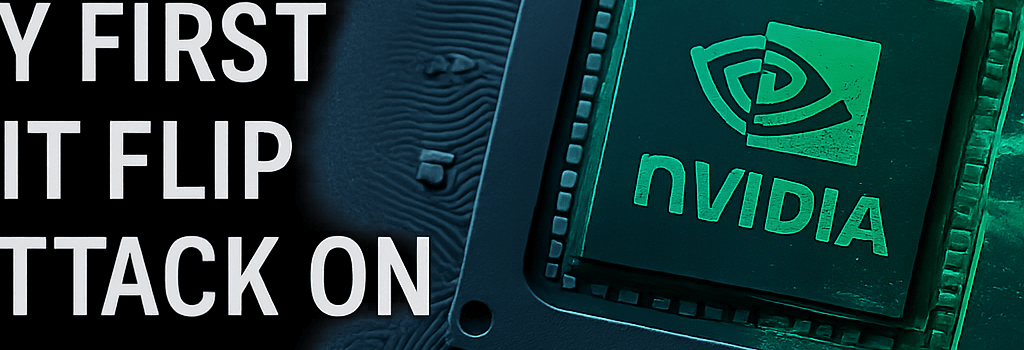NVIDIA GPUs Targeted by First Bit-Flip Attack on GDDR6 Memory

GPUHammer has shattered long-held assumptions about the invulnerability of graphics DRAM. For the first time, academic researchers have induced Rowhammer bit flips in the onboard GDDR6 memory of NVIDIA’s flagship RTX A6000 GPU, raising urgent questions about GPU security in AI, HPC and cloud environments.
Background: Rowhammer and the Rise of GPU Threats
Rowhammer is a hardware fault-induction technique that exploits the physics of DRAM. By repeatedly accessing (“hammering”) a row of memory cells, an attacker can disturb the charge in adjacent rows, flipping bits from 0 to 1 or vice versa. Since its discovery in 2014, Rowhammer has targeted DDR3 and DDR4 modules attached to CPUs. GPUs, with their on-board GDDR modules and proprietary controllers, were believed to be out of reach—until now.
Attack Methodology: How GPUHammer Works
Led by University of Toronto researchers Gururaj Saileshwar, Chris S. Lin and Joyce Qu, GPUHammer overcomes several unique GPU hurdles:
- Address Mapping Reverse-Engineering: GDDR6’s thousands of banks and bank groups are physically interleaved. The team used side-channel timing to reconstruct the GPU’s row–bank mapping.
- Row Activation Patterns: By issuing carefully timed global memory read instructions via CUDA, they created activation loops at nanosecond granularity to destabilize neighboring rows.
- Targeted Bit Flips: Flipping a single bit in the exponent of a 32-bit IEEE-754 weight (2^y format) can multiply its value by 2^128, catastrophically corrupting neural network outputs.
The proof-of-concept flipped bits in a 3D U-Net inference model, driving accuracy from 80% down to 0.1%—a change so drastic that it effectively “kills” the model.
Technical Deep Dive: GDDR6 vs. DDR4 Vulnerabilities
- Higher Refresh Rate: GDDR6 refreshes rows up to 8× faster than DDR4, but GPUHammer’s hammer loops still outpace the refresh timings at critical junctures.
- On-Die Termination: Proprietary on-die terminations and signal equalizers in GDDR6 board packages add noise, complicating reliable hammering.
- Controller Obscurity: GPU memory controllers do not expose physical addresses to the OS, forcing attackers to build a reverse-mapping from timing and bank conflict measurements.
Mitigation: ECC and Its Performance Trade-offs
NVIDIA has formally recommended enabling system-level ECC on susceptible architectures (e.g., Ampere A6000). ECC implements SECDED (Single Error Correction, Double Error Detection) codes, which automatically correct single-bit errors and flag double-bit errors.
- ~12% reduction in memory bandwidth under heavy ML inference workloads.
- ~6.25% loss in effective memory capacity due to ECC overhead.
- Up to 10% overall performance degradation on large-memory applications like medical imaging and autonomous driving models.
“With just one flipped bit, accuracy can crash from 80% to 0.1%, rendering it useless,” says Saileshwar. On-die ECC in newer H100 (HBM3) and upcoming GDDR7 GPUs may offer stronger resilience, but targeted Rowhammer tests are still pending.
Implications for Cloud Service Providers
GPU sharing in multi-tenant environments amplifies risk. AWS, Google Cloud and Azure all offer A6000 instances:
- AWS Nitro: AWS enables hardware-enforced ECC and custom memory isolation to block GPUHammer payloads.
- Google Cloud: GPU Shield partitions physical GPUs across projects, reducing cross-tenant attack surfaces.
- Azure Confidential: Microsoft’s confidential computing VMs combine SGX-like enclaves with ECC-on GPUs for defense in depth.
Expert Opinion: Memory Lab Insights
“This research demonstrates that even advanced GDDR6 modules are not immune to physical attack vectors,” says Dr. Linda Xu, Senior Researcher at Stanford’s Memory Systems Lab. “Future DRAM standards like GDDR7 must integrate on-die ECC and tailored refresh strategies to defend against row disturbances.”
Future Mitigations and Research Directions
Beyond ECC, researchers are exploring:
- Targeted Row Refresh (TRR): Dynamic adjustment of refresh intervals for hot rows to pre-empt bit flips.
- Hardware PUF-Based Mapping: Using Physically Unclonable Functions to randomize row–bank mappings at boot, invalidating reverse-engineered layouts.
- DRAM Chipkill ECC: Multi-bit correction schemes embedded at the die level, as seen in HBM3’s Chipkill implementations.
Upcoming presentations at the 2025 Usenix Security Conference will delve deeper, and kernel patches for Linux’s NVIDIA drivers are already in review to enable stricter memory controller throttling.
Key Takeaways
- GPUHammer is the first successful Rowhammer attack on discrete GPUs, targeting GDDR6 memory.
- Enabling ECC mitigates single-bit flips but incurs up to 10% performance overhead.
- Cloud providers are rapidly deploying hardware isolation and ECC-by-default to protect multi-tenant GPUs.
- Long-term defenses will require architectural changes: on-die ECC, TRR and randomized mapping.